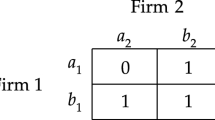Abstract
Coalescent argumentation is a normative ideal that involves the joining together of two disparate claims through recognition and exploration of opposing positions. By uncovering the crucial connection between a claim and the attitudes, beliefs, feelings, values and needs to which it is connected dispute partners are able to identify points of agreement and disagreement. These points can then be utilized to effect coalescence, a joining or merging of divergent positions, by forming the basis for a mutual investigation of non-conflictual options that might otherwise have remained unconsidered. The essay proceeds by defining and discussing ‘argument’, ‘position’ and ‘understanding’. These notions are then brought together to outline the concept of coalescent reasoning.
Similar content being viewed by others
References
Bavelas, J.: 1990, ‘Some Problems with Linking Goals to Discourse’, in Tracy, Karen (ed.),Understanding Face to Face Interaction: Issues Linking Goals and Discourse, Erlbaum Assoc., Hillsdale, NJ, 119–130.
Brown, P. and S. Levinson: 1987,Politeness: Some Universals in Language Usage, Cambridge UP: Cambridge, Eng. [orig. 1978].
Burleson, B. B.: 1981, ‘The Senses of Argument Revisited’,Summer Conference On Argumentation, Annandale, Va:SCA, 955–979.
Craig, R. T.: 1986, ‘Goals in Discourse’, in D. G. Ellis and W. A. Donohue (eds.),Contemporary Issues in Language and Discourse Processes, Erlbaum, Hillsdale, NJ.
Eemeren, van F. and R. Grootendorst: 1988, ‘Rationale for a Pragma-Dialectical Perspective’,Argumentation 2, 271–292.
Gilbert, M. A.: 1994, ‘Multi-Modal Argumentation’,Philosophy of the Social Sciences 24, 2.
Gilbert, M.: 1994a, ‘Feminism, Argumentation And Coalescence’,Informal Logic 16(2), 95–113.
Goffman, E.: 1959,The Presentation of Self in Everyday Life, Doubleday, Garden City, NY.
Grice, P.: 1989, ‘Logic & Conversation’, inStudies In the Way of Words, Harvard U. P., Cambridge, MA (orig., 1975).
Oxford English Dictionary: 1972, The Compact Edition, Oxford University Press, Oxford.
Quinve, W. V. and J. S. Ullian: 1970,The Web of Belief, Random House, New York.
Walton, D. N.: 1989, ‘Dialogue Theory for Critical Thinking’,Argumentation V 3 nr 2.
Walton, D.: 1992,The Place of Emotion in Argument, The Pennsylvania S. U. P., University Park, PA.
Author information
Authors and Affiliations
Rights and permissions
About this article
Cite this article
Gilbert, M.A. Coalescent argumentation. Argumentation 9, 837–852 (1995). https://doi.org/10.1007/BF00744761
Issue Date:
DOI: https://doi.org/10.1007/BF00744761




